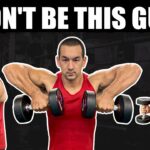The quadriceps are one of the largest muscles in the human body and a signifier of strength, dedication, and mental fortitude. It’s no wonder building powerful legs is a dream of many fitness enthusiasts.
But what are the best quad exercises for developing the lower body? Is the squat enough, or do you need to incorporate other movements?
Don’t panic. We’ve compiled the 9 best quadriceps exercises so you can build a powerful lower body.
Jump to:
Quad Muscle Anatomy
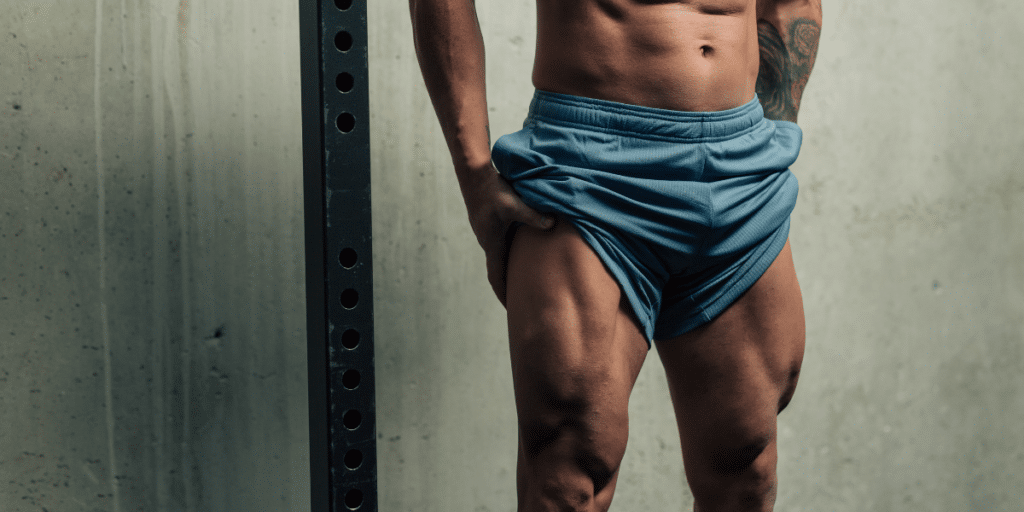
Quadricep femoris muscle actually translates to “four-headed muscle of the femur” in Latin, as it consists of four separate muscles. The different components of the quadriceps muscle include the following:
- Vastus intermedius
- Vastus medialis oblique
- Vastus lateralis
- Rectus femoris
The four individual muscles make up your thigh muscles, covering the front and sides of the femur.
The rectus femoris muscle is located in the middle of the thigh, covering much of the other muscles. It sits closest to the skin, making it the most visible.
The vast lateralis is on the exterior of the thigh and is the most powerful and largest muscle in the quadriceps.
The smallest muscle is the vastus medialis, located on the inner portion of the thigh. The vastus intermedius rests between the lateralis and medialis. It’s the deepest muscle in the quadriceps, covered by the rectus femoris.
Quadriceps Function
As a major muscle in the lower body, the quadriceps are used in countless everyday movements. You use these leg muscles when you run, jump, kick, get out of chairs, walk, and during leg workouts.
The primary function of the quads is to keep the knee stable and help straighten it.
Weak quads can lead to injury, halt gym progress, and make daily life more difficult. It’s critical to train the lower body with effective quad workouts to avoid these issues.
The Benefits of Strong Quads
Do you really need beefy quad muscles, or are they all for show? Our answer is yes; there are enormous mobility benefits and strength gains when you employ quad-strengthening exercises in your regimen.
Some of the primary benefits include better athletic performance, more functional strength, and a lower risk of injury. Here’s a breakdown of these advantages in more detail.
Carry Over to Other Compound Exercises
The quadriceps are required for heavy compound lifts, like the barbell back squat, power clean, and deadlift. Improving your quad strength will increase your performance across these lifts and other athletic movements.
You may notice an increase in your compound lifts, more mobility, and better coordination after a few weeks of consistent quad exercises—not to mention an increase in size.
Powerful quads are another must if you compete in powerlifting, strongman, bodybuilding, or CrossFit competitions.
Lowers the Chance of Injury
Stronger quads don’t only lead to an aesthetic physique and powerful pulls; they can significantly lower your chance of injury.
The quadriceps are critical for knee joint stabilization for movements inside and outside of the gym.
The individual muscles in the quads work in tandem to protect the knee, allowing you to stay mobile and agile.
Roughly 25% of adults have bad knees and suffer from knee pain. Strengthening the muscles and improving your knee health can reduce these chances significantly.
Improves Functional Strength
Mobility issues are much more common than you might think—one survey from the CDC found that roughly 18% of adults 18 and older had some kind of difficulty walking or climbing up stairs.
Fortunately, many quadricep movements are functional exercises. Building functional leg strength will help you walk, get out of chairs, lift things off the ground, and keep you mobile into old age.
Quadriceps exercises can also help with tight calf muscles, hip flexion, and lower body stability. These are important qualities to live an active and comfortable life, regardless of your age.
Start With a Warm Up
It’s critical to warm up and stretch your body before starting the first leg exercise of your training session. Warm-ups prepare your muscles for difficult exercises, increase your range of motion, and reduce the chance of injury.
So, where do you start?
- Start with 5–10 minutes of light cardio: This is to increase your body temperature and get your blood pumping. You can use a stair climber, treadmill, jump rope, or similar options. The goal is to raise your heart rate to 55–65% of your maximum limit.
- Perform some dynamic stretches: Next, you’ll want to perform dynamic stretches like leg swings, bodyweight squats, and lunges. This is to get your joints primed and ready for a full range of motion and reduces the risk of quadriceps sports injury.
- Start with lighter sets: Don’t start with heavy weights right away. Instead, use lighter weights and gradually increase the load until you reach your working set. This will prepare you mentally and physically for heavier loads.
This may seem like a lot, but it’s critical to prepare your mind and body before each training session. A proper warm-up will improve your athletic performance and reduce the risk of injury or strain.
1. Front Squat
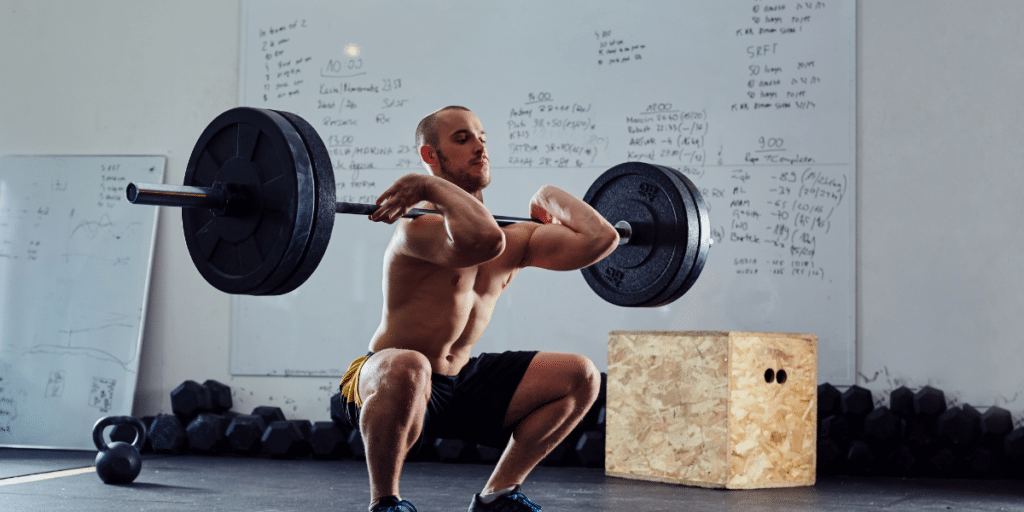
The Barbell Front Squat is one of the best exercises for building muscle in the quadriceps. This squat variation requires you to keep your torso upright, moving the load to your quads.
It’s a heavy lift, allowing you to add several weight plates to the bar, but it can be a difficult exercise for beginners. This is because it requires more mobility in the upper and lower body compared to back squats.
Regardless, the front barbell squat is perfect for muscle growth, developing explosive power, and balancing your physique.
Benefits
- Balances lower body routines by adding more quadricep engagement.
- Strength gains carry over to other heavy lifts, like the back squat, deadlift, and power clean.
- Fantastic for incorporating more lower body volume and engaging the core.
How to Perform
- Place a barbell in a squat rack at a height that’s around the same as your shoulders.
- Stand in front of the bar and lift it onto your upper chest and shoulders.
- Bend your arms to hold the bar securely with your fingers underneath it, and keep your elbows pointing upward.
- Stand up straight and tighten your stomach muscles.
- Keep the barbell in the same position on your chest and shoulders as you slowly lower yourself into a squatting position.
- Once you reach the lowest point of the squat, push back up using your leg muscles to stand tall again.
- Throughout the exercise, remember to keep your torso upright, your core muscles tight, and your elbows lifted.
Mistakes to Avoid
- Allowing the elbows to drop: Keep the elbows pointing up throughout the squat to maintain stability and prevent the barbell from rolling forward.
- Leaning too far forward: Maintain an upright torso during the squat to avoid excessive strain on the lower back and to engage the correct muscles effectively.
- Not bracing the core: Remember to engage your core muscles throughout the movement to support your spine and maintain a strong, stable posture.
2. Goblet Squats
Another stellar exercise for quads is the Goblet Squat. It’s similar to the front squat, as you place the weight in front of the body, engaging the quadriceps more. However, the technique doesn’t require as much mobility, making this variation ideal for beginners.
You can select between a dumbbell and a kettlebell. Besides helping you develop lower body strength, the goblet squat will engage the entire body, including the upper back and core.
Benefits
- Incredibly accessible for newcomers and veterans.
- It only requires a dumbbell or kettlebell.
- Full-body muscle engagement to strengthen the legs, upper body, and core.
How to Perform
- Pick up a kettlebell or dumbbell using both hands and hold it against your upper chest with your thumbs touching it.
- Stand straight with your shoulders pulled back and down. Tighten your stomach muscles to support your back.
- Bend your knees and hips to lower yourself until your thighs are parallel to the floor.
- Push through your feet to stand back up again.
Mistakes to Avoid
- Rounding the back: Keep your back straight and chest up during the squat to avoid putting unnecessary stress on the spine.
- Allowing the knees to cave in: Make sure your knees track in line with your toes throughout the movement to prevent potential knee strain or injuries.
- Lifting heels off the ground: Keep your feet flat on the floor and distribute the weight evenly through your heels and midfoot to maintain balance and stability during the squat.
3. Bulgarian Split Squat
Incredibly challenging and effective, what’s not to love about the Bulgarian Split Squat?
The Bulgarian variation is a unilateral movement, meaning it trains one leg at a time. This helps with muscle imbalances, coordination, and core strength and makes your quadriceps stronger.
It’s an advanced exercise that requires coordination and mental fortitude, but it’s well worth adding to your routine.
Benefits
- Unilateral movement engages one side at a time, addressing muscle imbalances and asymmetries.
- Challenging exercise that improves coordination, balance, and stability.
- Ideal for engaging the quadriceps and adding more training volume.
How to Perform
- Stand a few feet away from an elevated surface, like a weight bench or box.
- Place your back foot on the elevated surface, making sure both knees bend at 90 degrees.
- If you’re using free weight, hold it to stay balanced. Tighten your core and go down into a lunge.
- Lower your back knee towards the ground until it reaches its lowest point.
- Push strongly through your front foot to stand back up.
Mistakes to Avoid
- Incorrect foot placement: Ensure your front foot is far enough from the bench to maintain a 90-degree angle when your knee is bent, and the back foot should be placed securely on the bench.
- Not maintaining an upright posture: Keep your upper body straight throughout the movement, avoiding excessive leaning forward to prevent strain on your back.
- Neglecting proper balance: Focus on distributing your weight evenly between the front and back leg to prevent wobbling or loss of stability during the exercise.
4. Hack Squat
If you have access to a Hack Squat machine, you need to take advantage of it as soon as possible. This is one of the best quadriceps exercises, but it targets the entire lower body making it well worth your time.
It has similarities to other compound lifts, making it easy for advanced and novice lifters. The machine provides balance and stability, so you can go pretty heavy without many concerns.
Benefits
- Safety mechanisms allow you to load heavy weights without much concern.
- The movement pattern is natural and carries over to traditional squats.
- Engages the quadriceps, hamstrings, glutes, and calves.
- It places less stress on the core and lower back.
How to Perform
- Stand on the foot platform in a position similar to your back squat stance.
- Keep your torso stable, engage your core muscles, and ensure your lower back is flat against the back pad.
- Lower your body until your thighs are parallel to the foot platform.
- Push through your heels to return to the starting position.
Mistakes to Avoid
- Incorrect foot positioning: Ensure your feet are placed at the appropriate distance on the platform, shoulder-width apart or slightly wider, to maintain balance and target the right muscles.
- Not using the full range of motion: Lower yourself down until your thighs are parallel to the platform or even lower, but avoid bouncing at the bottom position.
- Rounding the back: Keep your back straight and avoid rounding or arching your spine during the movement to prevent potential injuries and maintain proper form.
5. Trap Bar Deadlift
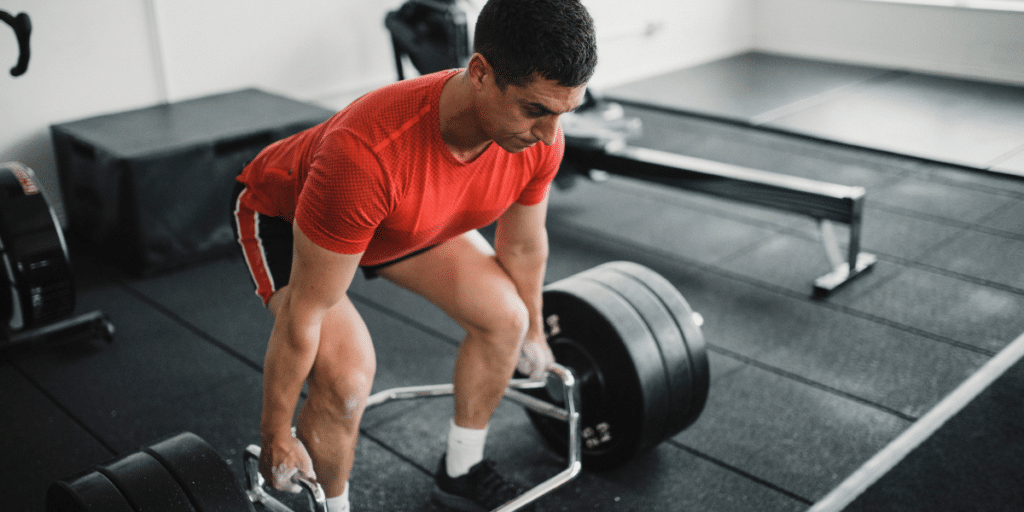
Compared to the traditional barbell deadlift, the Trap Bar Deadlift engages the quadriceps more and places less strain on the lower back. It’s a compound, full-body movement that will help you develop strength, power, and endurance.
One of the benefits of the trap bar is that you can load more weight compared to the conventional deadlift. Because the weights are on either side of the body, there is less stress on the lower back and joints.
Benefits
- Easier on the lower back and joints compared to the conventional deadlift.
- You can load more weight with the trap bar compared to the traditional barbell.
- It engages the quadriceps more while targeting the entire body.
How to Perform
- Step into the center of the hex bar with your feet shoulder-width apart.
- Bend at your hips, pushing your glutes backward. Slightly bend your knees and grab the bar with a neutral grip (palms facing you). Keep your back straight and chest up.
- Push through your feet to lift the bar off the ground. Keep your knees in place, and stand almost straight before fully straightening your knees. The bar should be in front of your thighs.
- To lower the bar, follow the same pattern and repeat for the desired number of repetitions.
Mistakes to Avoid
- Incorrect grip placement: Make sure your hands are evenly spaced on the handles of the trap bar to maintain balance and avoid undue strain on one side of your body.
- Rounded back during the lift: Keep your back flat and straight throughout the entire movement to protect your spine and reduce the risk of injury.
- Using improper lifting technique: Focus on engaging your legs and hips to lift the weight, avoiding excessive reliance on your back muscles, and maintaining a controlled and steady lifting motion.
6. Step-Up
The Step-Up is a fantastic functional exercise to include in your training regimen. It will burn your quadriceps, improve your coordination, and help you develop ankle mobility. It’s an easy move for beginners and can be performed with or without weight.
Benefits
- Mimics everyday movements make it perfect for improving functional strength.
- Easy for beginners, doesn’t require much equipment, and is accessible.
- It can be performed with or without weight.
How to Perform
- Begin by positioning one foot firmly on a step-up box or bench, making sure your entire foot is on the surface. Allow your other foot to hang off the edge.
- Lower the foot that’s hanging off the step while using the opposite leg to support and control your body weight.
- Lightly touch your heel on the ground, and then push through the step with the working leg to go back to the starting position.
- That completes one repetition. Repeat the same pattern with the opposite leg.
Mistakes to Avoid
- Using improper step height: Choose a step or platform that allows your knee to bend at a 90-degree angle when your foot is placed on it. Avoid using a step that is too high, as it may cause strain or instability.
- Not engaging the core: Remember to brace your core muscles throughout the movement to provide stability and support to your spine and prevent overarching of your lower back.
- Pushing off the back foot excessively: Focus on using the strength of your front leg to lift your body instead of pushing off too forcefully with your back foot, which can lead to an uneven movement pattern and decreased effectiveness of the exercise.
7. Leg Press

The Leg Press is a staple exercise in many lifters’ training regimens. It’s accessible, safe, and effective, whether you’re a gym veteran or a complete newcomer. It doesn’t require as much core stability as there are built-in safety mechanisms.
You can load heavy weights on the leg press, allowing you to develop strength and power in your quadriceps. Using a lower foot position will engage the quadriceps more, allowing you to target the most muscle fibers.
Benefits
- Most gyms have a leg press machine, making it an easy addition for most regimens.
- It can be loaded with heavy weights, as it places less stress on the lower back and core.
- Adjusting your foot placement allows you to target the inner and outer quadriceps.
- Safety mechanisms make it easy for new lifters to learn the proper technique.
How to Perform
- Position your feet on the sled of a leg press machine, ideally in a stance similar to your regular squat position.
- Push the sled out of the rack and lower the safety bars.
- Lower the sled toward your chest in a controlled manner until your thighs reach a 90-degree angle.
- Press the sled back up, but avoid fully locking out your knees at the top of the exercise.
Mistakes to Avoid
- Improper foot placement: Position your feet at an appropriate width on the footplate to target the desired muscle groups and prevent discomfort or injury.
- Locking out the knees: Avoid fully straightening your knees at the top of the movement, as it can transfer stress to the joints and reduce muscle engagement.
- Overloading with excessive weight: Choose a weight that allows you to perform the exercise with proper form and control. Avoid using too much weight, which can compromise your technique and lead to potential injuries.
8. Walking Lunges
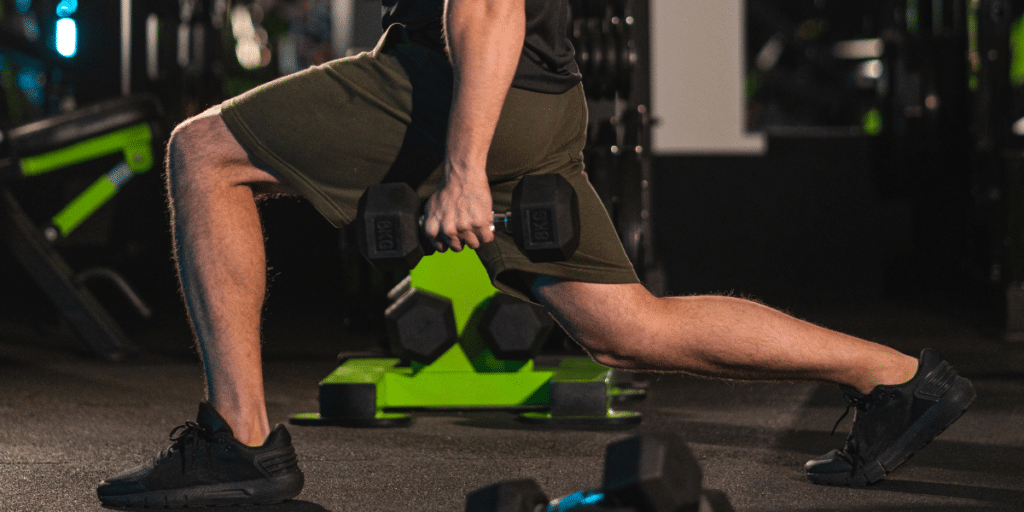
Lunge variations are a great exercise to have in your back pocket for quadriceps and lower body growth. This beginner-friendly lunge is ideal for targeting each leg at a time, addressing any strength or coordination imbalances.
You can perform this movement with or without weight. Walking lunges can also be used as part of a dynamic warm-up to prepare your lower body for heavier movements, like the front barbell squat.
Benefits
- It can be performed as a warm-up with or without weight.
- Unilateral movement enhances coordination, muscle imbalances, stability, and strength.
- Easy to perform.
How to Perform
- Start by standing with your feet close together.
- Take a step forward, approximately 18-24 inches, and firmly place your foot on the floor.
- In this position, allow your front knee to move forward, pointing between your first and second toes, while your back knee lowers straight down toward the ground.
- Push through the floor with the forward foot and shift your body forward to stand upright, aligning your back foot with the position of your front foot.
- That completes one step. Now, repeat the same movement on the other side.
Mistakes to Avoid
- Incorrect step length: Take a step that is neither too short nor too long. Aim for a stride where both knees form a 90-degree angle when you lower into the lunge position.
- Collapsing the upper body: Keep your torso upright and avoid leaning too far forward or backward during the lunges. This ensures proper alignment and reduces the risk of strain on your back.
- Allowing the front knee to go past the toes: As you lunge forward, make sure your front knee stays behind your toes to protect the knee joint and maintain stability during the movement.
9. Leg Extension
The Leg Extension is an incredibly simple move that benefits beginners and veteran lifters alike. With the right technique, the leg extension will hone the entire quadriceps muscle. It doesn’t require the back, so it’s perfect for those with lower back pain or recovering from injury.
Benefits
- Many gyms have leg extension machines making them more accessible.
- It doesn’t place any stress on the back or core, allowing you to isolate the quadriceps.
- It works well as an accessory exercise when paired with heavier lifts like the front squat and trap bar deadlift.
How to Perform
- Set the back pad of the machine to make sure the back of your knees fit comfortably against the seat’s edge.
- Straighten your knees by pushing against the ankle pad until they are fully extended.
- Bring the weight back down to the starting position with control. That’s one rep.
Mistakes to Avoid
- Using excessive weight: Choose a weight that allows you to complete the exercise with controlled and smooth movements. Avoid using too much weight, which may lead to jerky motions and potential strain on the knee joint.
- Rounding the back: Maintain a straight back throughout the exercise and avoid arching or rounding your spine to prevent unnecessary stress on the lower back.
- Locking out the knees: Do not fully lock out your knees at the top of the movement. Keep a slight bend in your knees to maintain tension on the muscles and avoid transferring stress to the joint.
Frequently Asked Questions (FAQ)
What Is the Most Effective Quad Exercise?
One of the most effective quad-strengthening exercises is the Barbell Front Squat. This is a compound movement that engages the front of your thighs alongside the upper back, glutes, and hamstrings. It engages the quadriceps more than the conventional back squat.
Are 4 Exercises Enough for Quads?
Yes, four exercises are enough to strengthen the quadriceps as long as you’re training enough each week. You might train the lower body 2–4 times a week with a rest day in between sessions. Some exercises to consider are the front squat, Bulgarian split squat, goblet squat, and leg extension.
How Can I Get Better Quads Fast?
You’ll need to train your lower body 2–4 times a week, get adequate rest, and eat enough protein. Some exercises to incorporate include the front squat, leg extension, and Bulgarian split squat. Make sure you’re using challenging weights and rep ranges that suit your fitness goals.














